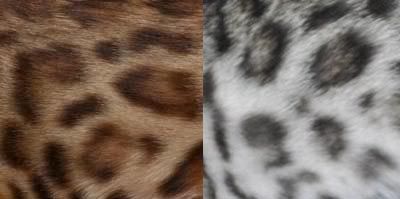Highland Lynx cats were developed by crossing two existing breeds--Desert Lynx cats and Jungle Curls. The primary foundation breed for Highland Lynx is the Desert Lynx*. Outcrosses to the Jungle Curls were made specifically to add the unique curled ears to the cats. Essentially, Highland Lynx are Desert Lynx with curled ears. They are strong, muscular cats which are medium in length with longer hind legs, and toes may be tufted. They are very alert, intelligent cats. Males are larger than females and slower to mature. These cats come in both long and short hair.
The head is large but not round, with a full, well-developed muzzle that is almost square in appearance, with prominent whisker pads.
The curled ears are smaller than in the Desert Lynx and set wide apart, usually with feathering and tufts on the tip. Ears curl backwards at the tips. The degree of the curl may be slight or extreme, with the tip of the ear actually curling back and touching the back side of the ear. The gene which causes the ear to curl actually hardens the cartilage in the ear dwarfs the ear size. The gene for curled ears is a dominant gene.
The tail may come half way to the ground, or it may be lacking entirely, as in the Manx, or it may be any length in between.
Highland Lynx officially come in three coat patterns in all eumelanistic and melanistic colors--ebony, blue, sorrel, fawn, chocolate, lilac, red, and cream --including silvers, cameos, sepias, minks, and snows. The coat patterns are tawny (ticked), leopard (spotted), and clouded leopard. Solid colored cats, as well as cats in classic and mackerel tabby, do sometimes occur.
The leopard pattern is a spotted tabby pattern. It is marked by spots of the darker color, most prominent on the sides of the body and the belly. The spots may vary in size and shape, but should be evenly distributed. Preference is given to rosette spots which are formed by a part-circle of spots around a distinctly lighter center. Contrast with ground color may not be as distinct as in some spotted breeds . A dorsal stripe runs the length of the body to the tip of the tail. The stripe is ideally composed of spots. The markings on the face and forehead are typical tabby markings, with the underside of the body having distinct spots. Legs and tail are barred. In the sepia, mink, and snow subdivisions, it is desirable for ghost leopard spots to appear on the bodies.
The tawny pattern is a ticked tabby pattern marked by ticking on the body hair with various shades of the marking color and ground color, with the outer tipping being the darkest and the undercoat being the ground color. The body may exhibit a barely perceptible spotted pattern. The tail, legs, and face will have tabby pencilings. Necklace tracings will are also frequently seen.
The clouded leopard pattern, while derived from modifications to the classic tabby gene, is different from the classic tabby pattern, with as little bull's eye similarities possible. The pattern gives the impression of marble, preferably with a horizontal flow. Vertical stripes are undesirable. Contrast should be good, with distinct shapes and sharp edges. The belly must be spotted.
Outcrosses to either unregistered or purebred cats are permitted. However, such crosses should be carefully chosen to complement the overall type of the Highland Lynx cat.
Highland Lynx, Desert Lynx, and Mohave Bobs are part of the Desert Lynx breed group in the Rare & Exotic Feline Registry. In other words, Mohave Bobs, Highland Lynx, Desert Lynx, and Alpine Lynx may be bred together, with offspring registered as follows:
All white kittens (including straight and curled coats and straight or curled ears) are
registered as Alpine Lynx.
All non-white kittens with curled coats are registered as Mohave Bobs.
All non-white kittens with straight coats and straight ears are registered as Desert Lynx..
All non-white kittens with straight coats and curled ears are registered as Highland Lynx.
The curled ears of the Highland Lynx are caused by a dominant gene which both curls the ears and somewhat reduces the size of the ears. When these breeds are bred together, the straight-eared kittens resulting from the breeding do not carry any genes for curled ears.
Non-white kittens do not carry the gene for white color. Therefore, breeders wishing to work with Desert Lynx only would not have to worry about getting curled-eared recessive genes in Desert Lynx who have Highland Lynx in their ancestry. Breeders not wishing to work with the Alpine Lynx would not have to worry about white kittens as long as neither parent is an Alpine Lynx.
The curled coat is caused by a dominant gene. Breederes not wishing to work with Mohave Bobs do not have to worry about this as long as neither of the parents have curled coats.
These breeds are identical in body type.
*There are several breeds of cats whose origins are speculated to be intertwined with the bobcat. The most common ones are the Pixie Bob and those breeds in the Desert Lynx breed group (Desert Lynx, Highland Lynx, and Alpine Lynx). It is important to note that DNA testing on these cats has failed to show positive results for the presence of bobcat DNA, hence the reference to these cats being domestic cats.











